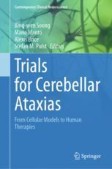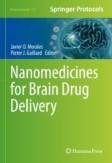Search
Search Results
-
Pharmacological Correction of Thiol-Disulphide Imbalance in the Rat Brain by Intranasal Form of Il-1b Antagonist in a Model of Chronic Cerebral Ischemia
Abstract —We studied the effect of intranasal administration of RAIL gel (Il-1b antagonist) to rats with experimental chronic cerebral ischemia caused...

-
Autosomal and X-Linked Degenerative Ataxias: From Genetics to Promising Therapeutics
Autosomal recessive cerebellar ataxias (ARCAs) refer to a large group of neurodegenerative disorders mainly affecting the cerebellum and the nervous...
-
Cognition Enhancers, Psychostimulants, and Psychedelic Drugs
Drugs that have predominant CNS stimulant actions with few drugs possessing additional cognition enhancing effect are discussed in this chapter....
-
Proteostasis failure exacerbates neuronal circuit dysfunction and sleep impairments in Alzheimer’s disease
Failed proteostasis is a well-documented feature of Alzheimer’s disease, particularly, reduced protein degradation and clearance. However, the...

-
Inflammatory Modulation of Compounds Derived from Turmeric (Curcuma longa) in Neurodegenerative Diseases
Neurodegenerative diseases, characterized by the degeneration of nerve cells that affect cognitive, sensory, and motor functions, represent a major...
-
Nanotechnology: A Daydream for Advanced Imaging, Diagnosis, and Therapeutic Approach for Cerebral Ischemia
Cerebral ischemia is one of the many deadly disorders that is caused due to the blocking of blood vasculatures in the brain and causing oxygen...
-
Revisiting the Role of Biologically Active Natural and Synthetic Compounds as an Intervention to Treat Injured Nerves
Traumatic lesions in nerves present high incidence and may culminate in sensorimotor and/or autonomic dysfunctions or a total loss of function,...

-
Effect of the Start Time of Cognitive Rehabilitation after Ischemic Stroke on the Level of Recovery
Objectives . To evaluate the results of cognitive rehabilitation carried out at different times after ischemic stroke (IS). Materials and methods . A...
-
Recycled Translation: Repurposing Drugs for Stroke
Stroke, which continues to be a leading cause of death and long-term disability worldwide, has often been described as a clinical graveyard. While...

-
Analysis of the Clinical Features and Imaging Findings of Pontocerebellar Hypoplasia Type 2D Caused by Mutations in SEPSECS Gene
Pontocerebellar hypoplasia type 2D (PCH2D) caused by SEPSECS gene mutations is very rare and only described in a few case reports. In this study, we...

-
Determination of the Prevalence of Postcovid Syndrome and Assessment of the Effectiveness of the Drug Cortexin in the Treatment of Neurological Disorders in Patients with Postcovid Syndrome. Results of the CORTEX Multicenter Clinical and Epidemiological Observational Program
Objectives. To study the prevalence and clinical manifestations of postcovid syndrome (PCS) in out-patients and to assess the efficacy of treatment...
-
Extracellular vesicles in malaria: an agglomeration of two decades of research
Malaria is a complex parasitic disease, caused by Plasmodium spp. More than a century after the discovery of malaria parasites, this disease...

-
Revolutionizing Stroke Care: Nanotechnology-Based Brain Delivery as a Novel Paradigm for Treatment and Diagnosis
Stroke, a severe medical condition arising from abnormalities in the coagulation-fibrinolysis cycle and metabolic processes, results in brain cell...

-
Nanovesicular-Mediated Intranasal Drug Therapy for Neurodegenerative Disease
Numerous neurodegenerative conditions, such as Alzheimer’s, Huntington’s, Parkinson’s, amyotrophic lateral sclerosis, and glioblastoma multiform are...

-
Application of Nanotechnology in Stroke Recovery
Stroke is a devastating condition, for which there is still no effective therapy. Nanotechnology is advanced and advantageous over conventional drug...
-
Insights into Therapeutic Targets in Stroke
A stroke is also called a cerebrovascular accident which damages the brain from interruption of blood supply. Vast research has been developed to...
-
Liposomes as Brain Targeted Delivery Systems
Liposomes and lipid vesicles are leading strategies in allowing brain targeted drug release with prominent success. Liposome rational design...
-
Direct and Indirect Neurological Signs of COVID-19
Objective. To systematize the neurological manifestations of COVID-19. Materials and methods. A systematic computerized analysis of all currently...
-
Cannabis as a Unique and Valuable Nutraceutical Formulation for the Current and Future Global Wellbeing
Nutraceuticals are a type of nutritional supplement used for healthcare in addition to nourishment. They can be used to maintain the body’s structure...
-
Epidemiology, clinical presentation, treatment, and follow‐up of chronic mercury poisoning in China: a retrospective analysis
BackgroundThere are no reports on the incidence of chronic mercury poisoning in a large population in China. This study investigated the...

